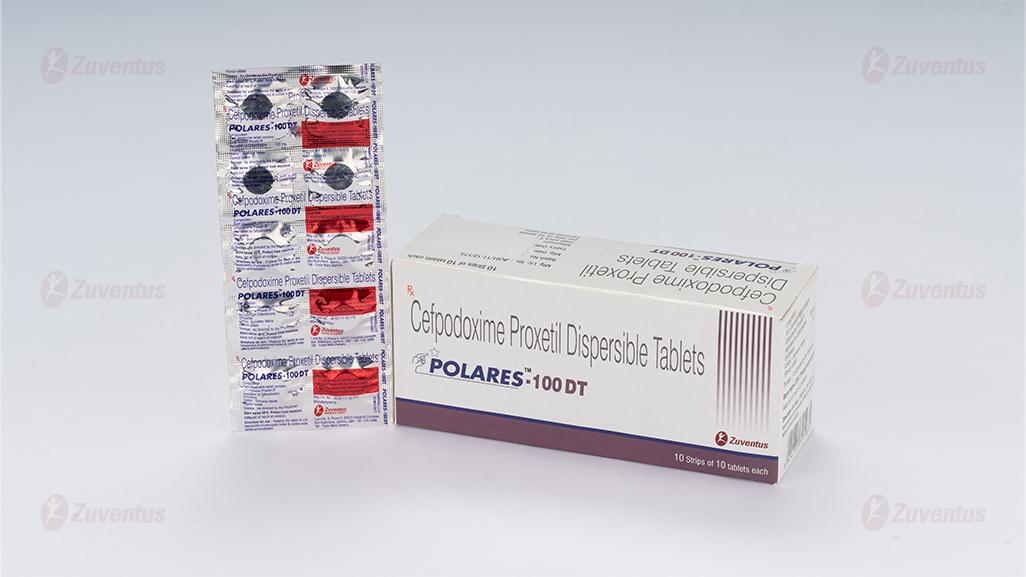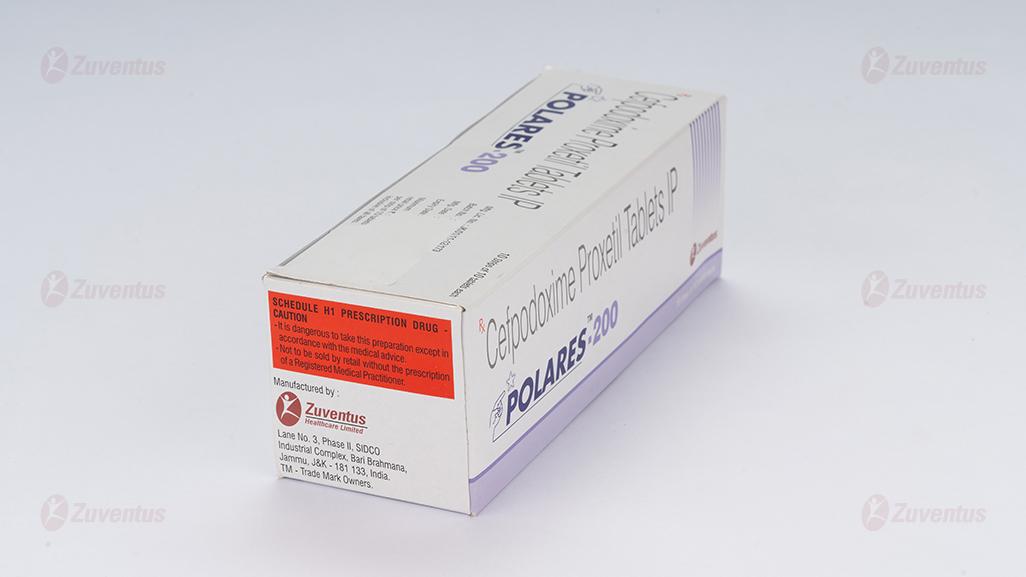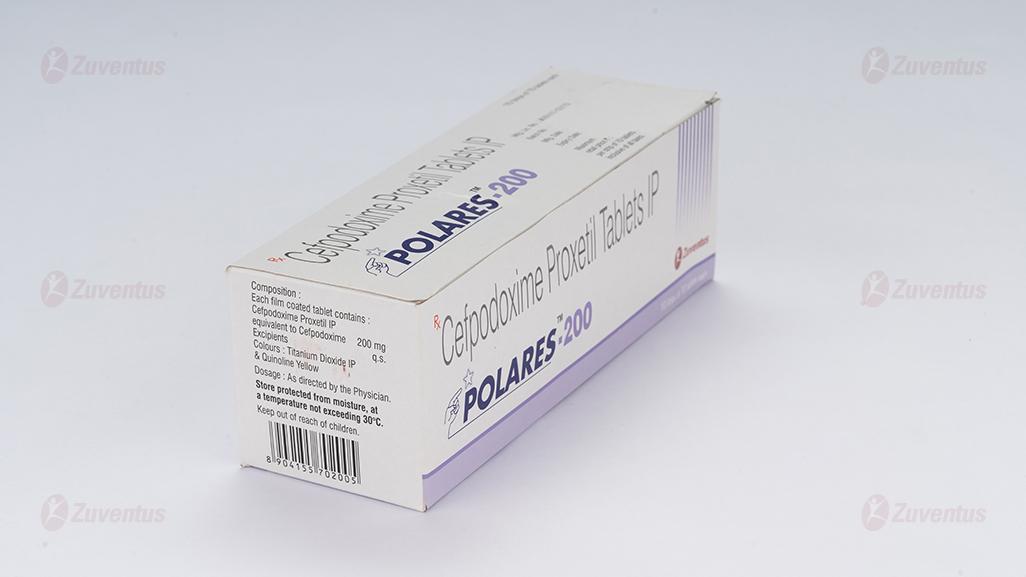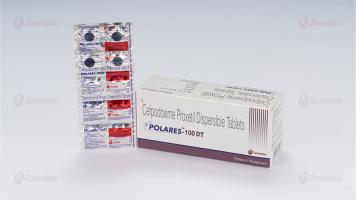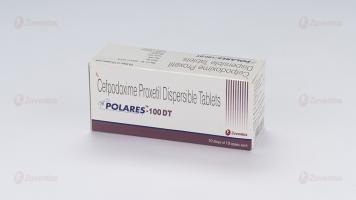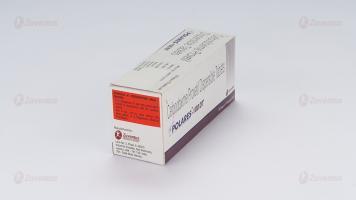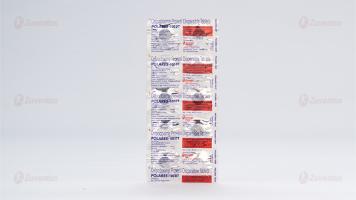Polares 100 DT & 200 Tablets
Therapy Area
Anti Infective
1.0 Name of the medicinal product
Cefpodoxime Proxetil Dispersible Tablets / Cefpodoxime Proxetil Tablets IP
2.0 Qualitative and quantitative composition
Polares-100 DT
Each uncoated dispersible tablet contains :
Cefpodoxime Proxetil IP
equivalent to Cefpodoxime 100 mg
Excipients
Colour : Quinoline Yellow
Flavour added
Polares-200
Each film coated tablet contains :
Cefpodoxime Proxetil IP
equivalent to Cefpodoxime 200 mg
Excipients q.s
Colours : Titanium Dioxide IP and
Quinoline Yellow
3.0 Dosage form and strength
Dispersible tablet 100 mg, Film coated tablet 200 mg
4.0 Clinical particulars
4.1 Therapeutic indications
Acute bronchitis, exacerbations of chronic bronchitis, bronchiolitis pneumonia, sinusitis, recurrent chronic tonsillitis, pharyngitis, acute otitis.
4.2 Posology and method of administration
Polares - 100 DT Tablets
Direction for use
Disperse the tablet in one teaspoonful of previously boiled and cooled water before administration. Cefpodoxime Proxetil 100 DT, should be administered orally with food to enhance absorption. The recommended dosages, durations of treatment, and applicable patient population are as described in the following chart. Infants and Pediatric Patients (age 2 months through 12 years)
| Type of Infection | Total Daily Dose | Dose Frequency | Duration |
| Acute otitis media | 10 mg/kg/day (Max 400 mg/day) | 5 mg/kg Q 12 h (Max 200 mg/dose) | 5 days |
| Pharyngitis and/or tonsillitis | 10 mg/kg/day (Max 200 mg/day) | 5 mg/kg/dose Q 12h (Max 100 mg/dose) | 5 to 10 days |
| Acute maxillary sinusitis | 10 mg/kg/day (Max 400 mg/day) | 5 mg/kg Q 12 hours (Max 200 mg/dose) | 10 days |
Polares-200 Tablets
Cefpodoxime Proxetil Tablets, should be administered orally with food to enhance absorption. The recommended dosages, durations of treatment, and applicable patient population are as described in the following chart. Adults and Adolescents (age 12 years and older)
| Type of Infection | Total Daily Dose | Dose Frequency | Duration |
| Pharyngitis and/or tonsillitis | 200 mg | 100 mg Q 12 hours | 5 to 10 days |
| Acute community acquired pneumonia | 400 mg | 200 mg Q 12 hours | 14 days |
| Acute bacterial exacerbations of chronic bronchitis | 400 mg | 200 mg Q 12 hours | 10 days |
| Acute maxillary sinusitis | 400 mg | 200 mg Q 12 hours | 10 days |
Patients with Renal Dysfunction
For patients with severe renal impairment (<30 mL/min creatinine clearance), the dosing intervals should be increased to Q 24 hours. In patients maintained on hemodialysis, the dose frequency should be 3 times/week after hemodialysis.
Patients with Cirrhosis
Cefpodoxime pharmacokinetics in cirrhotic patients (with or without ascites) are similar to those in healthy subjects. Dose adjustment is not necessary in this population
4.3 Contraindications
• patients with a known allergy to cefpodoxime or to the cephalosporin group of antibiotics.
• previous history of immediate and / or severe hypersensitivity reaction (anaphylaxis) to penicillin or other betalactam antibiotic.
4.4 Special warnings and precautions for use
Before therapy with cefpodoxime proxetil is instituted, careful inquiry should be made to determine whether the patient has had previous hypersensitivity reactions to cefpodoxime, other cephalosporins, penicillins, or other drugs. If cefpodoxime is to be administered to penicillin sensitive patients, caution should be exercised because cross hypersensitivity among beta-lactam antibiotics has been clearly documented and may occur in up to 10% of patients with a history of penicillin allergy. If an allergic reaction to cefpodoxime proxetil occurs, discontinue the drug. Serious acute hypersensitivity reactions may require treatment with epinephrine and other emergency measures, including oxygen, intravenous fluids, intravenous antihistamine, and airway management, as clinically indicated.
General precautions
In patients with transient or persistent reduction in urinary output due to renal insufficiency, the total daily dose of cefpodoxime proxetil should be reduced because high and prolonged serum antibiotic concentrations can occur in such individuals following usual doses. Cefpodoxime, like other cephalosporins, should be administered with caution to patients receiving concurrent treatment with potent diuretics. As with other antibiotics, prolonged use of cefpodoxime proxetil may result in overgrowth of non-susceptible organisms. Repeated evaluation of the patient’s condition is essential. If superinfection occurs during therapy, appropriate measures should be taken. Prescribing Cefpodoxime Proxetil, in the absence of a proven or strongly suspected bacterial infection or a prophylactic indication is unlikely to provide benefit to the patient and increases the risk of the development of drug resistant bacteria.
4.5 Interaction with other medicinal products and other forms of interaction
Antacids
Concomitant administration of high doses of antacids (sodium bicarbonate and aluminum hydroxide) or H2 blockers reduces peak plasma levels by 24% to 42% and the extent of absorption by 27% to 32%, respectively. The rate of absorption is not altered by these concomitant medications. Oral anticholinergics (e.g., propantheline) delay peak plasma levels (47% increase in Tmax), but do not affect the extent of absorption (AUC).
Probenecid
As with other beta-lactam antibiotics, renal excretion of cefpodoxime was inhibited by probenecid and resulted in an approximately 31% increase in AUC and 20% increase in peak cefpodoxime plasma levels.
Nephrotoxic drugs
Although nephrotoxicity has not been noted when cefpodoxime proxetil was given alone, close monitoring of renal function is advised when cefpodoxime proxetil is administered concomitantly with compounds of known nephrotoxic potential.
Drug/Laboratory Test Interactions
Cephalosporins, including cefpodoxime proxetil, are known to occasionally induce a positive direct Coombs’ test
4.6 Fertility, pregnancy and lactation
Pregnancy
There are, however, no adequate and well-controlled studies of cefpodoxime proxetil use in pregnant women. Because animal reproduction studies are not always predictive of human response, this drug should be used during pregnancy only if clearly needed.
Labor and Delivery
Cefpodoxime proxetil has not been studied for use during labor and delivery.
Lactation
Cefpodoxime is excreted in human milk. Because of the potential for serious reactions in nursing infants, a decision should be made whether to discontinue nursing or to discontinue the drug, taking into account the importance of the drug to the mother.
4.7 Effects on ability to drive and use machines
It may cause dizziness. Driving or operating machinery is to be avoided
4.8 Undesirable effects
In clinical trials using multiple doses of cefpodoxime proxetil granules for oral drop, 2128 pediatric patients (93% of whom were less than 12 years of age) were treated with the recommended dosages of cefpodoxime (10 mg/kg/day Q 24 hours or divided Q 12 hours to a maximum equivalent adult dose). There were no deaths or permanent disabilities in any of the patients in these studies. Twenty-four patients (1.1%) discontinued medication due to adverse events thought possibly- or probably-related to study drug. Primarily, these discontinuations were for gastrointestinal disturbances, usually diarrhea, vomiting, or rashes. Adverse events thought possibly- or probably-related, or of unknown relationship to cefpodoxime proxetil for oral drop in multiple dose clinical trials (N=2128 patients treated with cefpodoxime) were:
Incidence Greater Than 1% were:

Incidence Less Than 1%
Body: Localized abdominal pain, abdominal cramp, headache, monilla, generalized abdominal pain, asthenia, fever, fungal infection.
Digestive: Nausea, monilia, anorexia, dry mouth, stomatitis, pseudomembranous colitis. Hemic & Lymphatic: Thrombocythemia, positive direct
Coombs' test, eosinophilla, leukocytosis, leukopenia, prolonged partial thromboplastin time, thrombocytopenic purpura. Metabolic & Nutritional: Increased SGPT Musculo-Skeletal: Myalgia. Nervous: Hallucination, hyperkinesia, nervousness, somnolence. Respiratory: Epistaxis, rhinitis, Skin: Fixed drug eruption (FDE), skin moniliasis, urticaria, fungal dermatitis, acne, exfoliative dermatitis, maculopapular rash. Special Senses: Taste perversion. Laboratory Changes Significant laboratory changes that have been reported in adult and pediatric patients in clinical trials of cefpodoxime proxetil, without regard to drug relationship, were: Hepatic: Transient Increases in AST (SGOT), ALT (SGPT), GGT, alkaline phosphatase, bilirubin, and LDH. Hematologic: Eosinophilia, leukocytosis, lymphocytosis, granulocytosis, basophilia, mono- cytosis, thrombocytosis, decreased hemoglobin, decreased hematocrit, leukopenia, neu- tropenia, lymphocytopenia, thrombocytopenia, thrombocythemia, positive Coombs' test, and prolonged PT, and PTT. Serum Chemistry: Hyperglycemia, hypoglycemia, hypoalbuminemia, hypoproteinemia, hyperkalemia, and hyponatremia. Renal: Increases in BUN and creatinine. Most of these abnormalities were transient and not clinically significant. Reporting of suspected adverse reactions Reporting suspected adverse reactions after authorisation of the medicinal product is important. It allows continued monitoring of the benefit/risk balance of the medicinal product. Healthcare professionals are asked to report any suspected adverse reactions via email to: medico@zuventus.com By reporting side effects, you can help provide more information on the safety of this medicine.
4.9 Overdose
In acute rodent toxicity studies, a single 5 g/kg oral dose produced no adverse effects. In the event of serious toxic reaction from overdosage, hemodialysis or peritoneal dialysis may aid in the removal of cefpodoxime from the body, particularly if renal function is compromised. The toxic symptoms following an overdose of beta-lactam antibiotics may include nausea, vomiting, epigastric distress, and diarrhea.
5.0 Pharmacological properties
5.1 Mechanism of action
Cefpodoxime is a bactericidal agent that acts by inhibition of bacterial cell wall synthesis. Cefpodoxime has activity in the presence of some betalactamases, both penicillinases and cephalosporinases, of Gram-negative and Gram-positive bacteria.
5.2 Pharmacodynamic properties
Resistance to Cefpodoxime is primarily through hydrolysis by beta-lactamase, alteration of penicillin-binding proteins (PBPs), and decreased permeability. Cefpodoxime has been shown to be active against most isolates of the following bacteria, both in vitro and in clinical infections
Gram-positive Bacteria
Staphylococcus aureus (methicillin-susceptible strains, including those producing penicillinases) Staphylococcus saprophyticus Streptococcus pneumoniae (excluding penicillin-resistant isolates) Streptococcus pyogenes
Gram-negative Bacteria
Escherichia coli Klebsiella pneumoniae Proteus mirabilis Haemophilus influenzae (including beta-lactamase producing isolates) Moraxella catarrhalis Neisseria gonorrhoeae (including penicillinase-producing isolates) The following in vitro data are available, but their clinical significance is unknown. At least 90 percent of the following microorganisms exhibit an in vitro minimum inhibitory concentration (MIC) less than or equal to the susceptible breakpoint for cefpodoxime. However, the efficacy of cefpodoxime in treating clinical infections due to these microorganisms has not been established in adequate and well-controlled clinical trials.
Gram-positive Bacteria
Streptococcus agalactiae Streptococcus spp. (Groups C, F, G)
Gram-negative Bacteria
Citrobacter diversus Klebsiella oxytoca Proteus vulgaris Providencia rettgeri Haemophilus parainfluenzae
Anaerobic Gram-positive Bacteria
Peptostreptococcus magnus
5.3 Pharmacokinetic properties
In adult subjects, a 100 mg dose of oral suspension produced an average peak cefpodoxime concentration of approximately 1.5 mcg/mL (range: 1.1 to 2.1 mcg/mL), which is equivalent to that reported following administration of the 100 mg tablet. Time to peak plasma concentration and area under the plasma concentration-time curve (AUC) for the oral suspension were also equivalent to those produced with film-coated tablets in adults following a 100 mg oral dose. The pharmacokinetics of cefpodoxime were investigated in 29 patients aged 1 to 17 years. Each patient received a single, oral, 5 mg/kg dose of cefpodoxime oral suspension. Plasma and urine samples were collected for 12 hours after dosing. The plasma levels reported from this study are as follows:

Dose did not exceed 200 mg.
Distribution
Protein binding of cefpodoxime ranges from 22 to 33% in serum and from 21 to 29% in plasma
Effects of Decreased Renal Function
Elimination of cefpodoxime is reduced in patients with moderate to severe renal impairment (<50 mL/min creatinine clearance). In subjects with mild impairment of renal function (50 to 80 mL/min creatinine clearance), the average plasma half-life of cefpodoxime was 3.5 hours. In subjects with moderate (30 to 49 mL/min creatinine clearance) or severe renal impairment (5 to 29 mL/mincreatinine clearance), the half-life increased to 5.9 and 9.8 hours, respectively. Approximately 23% of the administered dose was cleared from the body during a standard 3-hour hemodialysis procedure.
6.0 Nonclinical properties
6.1 Animal Toxicology or Pharmacology
No known animal toxicology data
7.0 Description
Cefpodoxime proxetil is an orally administered, extended spectrum, semisynthetic antibiotic of the cephalosporin class. The chemical name is (RS)-1(isopropoxycarbonyloxy) ethyl (+) (6R,7R)-7-[2-(2-amino-4-thiazolyl)-2- {(Z)methoxyimino} acetamido]-3-methoxymethyl-8-oxo-5-thia-1-azabicyclo [4.2.0]oct-2-ene-2-carboxylate. Its empirical formula is C21H27N5O9S2 and its structural formula is represented below:

8.0 Pharmaceutical particulars
8.1 Incompatibilities
Not applicable
8.2 Shelf-life
Refer on the pack.
8.3 Packaging information
Polares 100 DT : A strip of 10 tablets each.
Polares 200 : A strip of 10 tablets each.
8.4 Storage and handing instructions
Polares 100 DT : Store below 30°C. Protect from moisture.
Polares 200 : Store protected from moisture, at a temperature not exceeding 30°C.
Keep out of reach of children
9.0 Patient Counselling Information
Patients should be counseled that antibacterial drugs including Cefpodoxime Proxetil, should only be used to treat bacterial infections. They do not treat viral infections (e.g., the common cold). When Cefpodoxime Proxetil, is prescribed to treat a bacterial infection, patients should be told that although it is common to feel better early in the course of therapy, the medication should be taken exactly as directed. Skipping doses or not completing the full course of therapy may (1) decrease the effectiveness of the immediate treatment and (2) increase the likelihood that bacteria will develop resistance and will not be treatable by Cefpodoxime Proxetil, or other antibacterial drugs in the future. Diarrhea is a common problem caused by antibiotics which usually ends when the antibiotic is discontinued. Sometimes after starting treatment with antibiotics, patients can develop watery and bloody stools (with or without stomach cramps and fever) even as late as two or more months after having taken the last dose of the antibiotic. If this occurs, patients should contact their physician as soon as possible
About leaflet
Read all of this leaflet carefully before you start taking this medicine because it contains important information for you.
- Keep this leaflet. You may need to read it again.
- If you have any further questions, ask your doctor.
- This medicine has been prescribed for you only. Do not pass it on to others. It may harm them, even if their signs of illness are the same as yours.
- If you get any side effects, talk to your doctor. This includes any possible side effects not listed in this leaflet.
What is in this leaflet
1. What POLARES 100 DT and 200 tablet is and what it is used for
2. What you need to know before you take POLARES 100 DT and 200 tablet
3. How to take POLARES 100 DT and 200 tablet
4. Possible side effects
5. How to store POLARES 100 DT and 200 tablet
6. Contents of the pack and other information
1. What POLARES 100 DT and 200 tablet is and what it is used for
Polares Tablets contains a medicine called cefpodoxime proxetil. This belongs to a group of antibiotics called ‘cephalosporins’. Polares Tablets are used to treat infections caused by bacteria. These include infections of the:
nose, sinuses (such as sinusitis)
throat (such as tonsillitis, pharyngitis)
chest and lungs (such as bronchitis, pneumonia)
skin (such as an abscess, ulcer, infected wound, inflamed hair follicles, carbuncles, furuncles, infections around the finger nails, a type of skin infection called cellulitis)
urinary system (such as cystitis, and kidney infections)
the sexually transmitted infection, gonorrhoea
2. What you need to know before you take POLARES 100 DT and 200 Tablets
Do not take this medicine and tell your doctor or pharmacist if:
• You are allergic (hypersensitive) to cefpodoxime, any other antibiotics including penicillin or to any of the other ingredients of this medicine (see Section 6: Further Information). Signs of an allergic reaction include: a rash, swallowing or breathing problems, swelling of the lips, face, throat and tongue.
Do not take this medicine if the above applies to you. If you are not sure, talk to your doctor or pharmacist before taking Polares Tablets.
Warnings and precautions Take special care with Polares Tablets
Check with your doctor or your pharmacist before taking this medicine if you:
Have ever had colitis
Have kidney problems
If you are not sure if any of the above applies to you, talk to your doctor or pharmacist before taking this medicine.
Taking other medicines
Please tell your doctor or your pharmacist if you are taking or have recently taken any other medicines. This includes
medicines you buy without a prescription, including herbal medicines. This is because Polares Tablets can affect the way some other medicines work. Also some medicines can affect the way Polares Tablets works.
In particular, tell your doctor if you are taking any of the following:
antacids (used to treat indigestion)
medicines for treating ulcers (such as ranitidine or cimetidine)
water tablets or injections (diuretics)
used to increase the flow of your water (urine)
aminoglycoside antibiotics (used to treat infections)
probenecid (used with a medicine called cidofovir to stop kidney damage)
coumarin anti-coagulants such as warfarin (used to thin the blood)
oestrogens such as in the contraceptive pill
Take antacids and medicines for ulcers 2-3 hours after Polares Tablets.
Tests
If you require any tests (such as blood or urine tests) while taking this medicine, please make sure your doctor knows that you are taking Polares Tablets.
Pregnancy and breast-feeding
Talk to your doctor before taking Polares Tablets if you are pregnant, might become pregnant or think you may be pregnant. Do not breast-feed if you are taking Polares Tablets. This is because small amounts may pass into the mother’s milk. If you are pregnant or breast-feeding talk to your doctor or pharmacist before taking any medicine.
Driving and using machinery
You may feel dizzy while you are taking this medicine. If this happens, do not drive or use any tools or machines.
Important information about some of the ingredients of Polares Tablets
Polares Tablets contain:
• Lactose: This is a type of sugar. If you have been told by your doctor that you cannot tolerate or digest some sugars talk to your doctor before taking this medicine. What you need to know before you take Polares Tablets
3. How to take Polares Tablets
Always take Polares Tablets exactly as your doctor has told you. You should check with your doctor or pharmacist if you are not sure.
Taking this medicine
- Take this medicine by mouth.
- Take this medicine with or straight after food
- If you feel the effect of your medicine is too weak or too strong, do not change the dose yourself, but ask your doctor.
How much to take
The dose of Polares Tablets depends on your needs and the illness being treated. Your doctor will advise you:
Adults
Infections of the nose/throat
- One Polares 200 tablet twice each day
Infection of the sinuses
- Two Polares 200 tablets twice each day
Infections of the chest and lungs
- One or two Polares 200 tablets, twice each day
Infections of the lower urinary system e.g. cystitis
- One Polares 200 tablet twice each day
Gonorrhoea
- Two Polares 200 tablets as a single dose
Infections of the upper urinary system such as kidney infections
- Two Polares 200 tablets twice each day
Skin infections
- Two Polares 200 tablets twice each day
People with kidney problems
Your doctor may need to give you a lower dose
Children
Children should be given Polares 100 DT.
Your doctor will advise you of the best way to take your medicine. Always follow his advice about when and how to take your medicine and always read the label on the box. Your pharmacist will also be able to help you if you are not sure.
Directions for reconstitution (Polares 100 DT)
Disperse the Polares 100 DT tablet in one teaspoonful (5 ml) of previously boiled & cooled water before administration
Blood tests
If you take this medicine for more than 10 days, the doctor or nurse may do a blood test. This is routine and nothing to worry about.
If you take more Polares Tablets than you should
If you have too much of this medicine, talk to your doctor straight away. The following effects may happen: confusion, lack of emotion or interest in anything and agitation.
If you forget to take Polares Tablets
If a dose is missed, do not worry. Just wait until the next dose is due. Do not take a double dose to make up for a forgotten dose.
If you stop taking Polares Tablets
Do not stop taking your medicine without talking to your doctor. You should not stop taking Polares Tablets just because you feel better. This is because the infection may come back or get worse again.
If you have any further questions on the use of this product, ask your doctor or pharmacist.
4. Possible side effects
Like all medicines, Polares Tablets can cause side effects, although not everybody gets them. Side effects are described by the number of patients expected to experience the reaction, using the following categories: very common (more than 1 in 10 patients), common (1 in 100 to 1 in 10 patients); uncommon (1 in 1,000 to 1 in 100 patients); rare (1 in 10,000 to 1 in 1,000 patients), extremely rare (Less than 1 in 10,000 patients); not known (cannot be estimated from the available data).
Tell your doctor straight away or go to the nearest hospital casualty department if you notice any of the following serious side effects, whose occurrence is rare, or extremely rare – you may need urgent medical treatment:
You have an allergic reaction. The signs may include: a rash, joint pain, swallowing or breathing problems, swelling of your lips, face, throat or tongue.
Blistering or bleeding of the skin around the lips, eyes, mouth, nose and genitals. Also flu-like symptoms and fever. This may be something called ‘Stevens-Johnson syndrome’.
Severe blistering rash where layers of the skin may peel off to leave large areas of raw exposed skin over the body. Also a feeling of being generally unwell, fever, chills and aching muscles. This may be something called ‘Toxic epidermal necrolysis’.
You have a skin rash or skin lesions with a pink/red ring and a pale centre which may be itchy, scaly or filled with fluid. The rash may appear especially on the palms or soles of your feet. These could be signs of a serious allergy to the medicine called ‘erythema multiforme’.
You get infections more easily than usual. This could be because of a blood disorder. This is more likely if you are taking the tablets for a long time.
Yellowing of the skin, eyes or mouth and feeling tired. You may also be more pale than normal. This could be because of a serious type of anaemia.
Other common side effects may include diarrhoea.
Stop taking your medicine and contact your doctor without delay if you get severe diarrhoea. This may be a symptom of a very serious side-effect called pseudomembraneous colitis.
Tell your doctor or pharmacist if any of the following, commonly occurring, side effects get serious or lasts longer than a few days
- Feeling sick (nausea) or being sick (vomiting)
- Stomach pains
- Flatulence (passing wind)
- Loss of appetite
- Headaches
- Feeling dizzy
- Ringing in the ears
- Feeling tired or weak
- Itching skin without rash
- Pins and needles
- Numbness or tingling feelings
Other side-effects, that rarely occur include blood disorders such as:
- neutropenia
- agranulocytosis
- thrombocytopenia
- lymphocytosis
- anaemia
- leukopenia
- leucocytosis
- Symptoms may include jaundice, feeling tired, sudden fever, frequent infections such as sore throat, mouth ulcers. Your doctor may want to monitor your blood count for changes in blood picture.
Reporting of side effects
If you get any side effects, talk to your doctor. This includes any possible side effects not listed in this leaflet. You can also report side effects directly: Website: www.zuventus.co.in and click the tab “Safety Reporting” located on the top of the home page. By reporting side effects, you can help provide more information on the safety of this medicine.
5. How to store Polares Tablets
Keep out of the reach and sight of children. Do not use Polares Tablets after the expiry date which is stated on the blister and carton after EXP. The expiry date refers to the last day of that month. Do not store above 25°C. Do not throw away medicines via wastewater or household waste. Ask your pharmacist how to throw away medicines you no longer use. These measures will help to protect the environment.
6. Contents of the pack and other information
What Polares Tablets contain
Each film-coated tablet contains the active ingredient cefpodoxime proxetil equivalent to 200 mg cefpodoxime and 100 mg cefpodoxime DT.
- Polares 100 DT: A strip of 10 tablets each.
- Polares 200: A strip of 10 tablets each.

